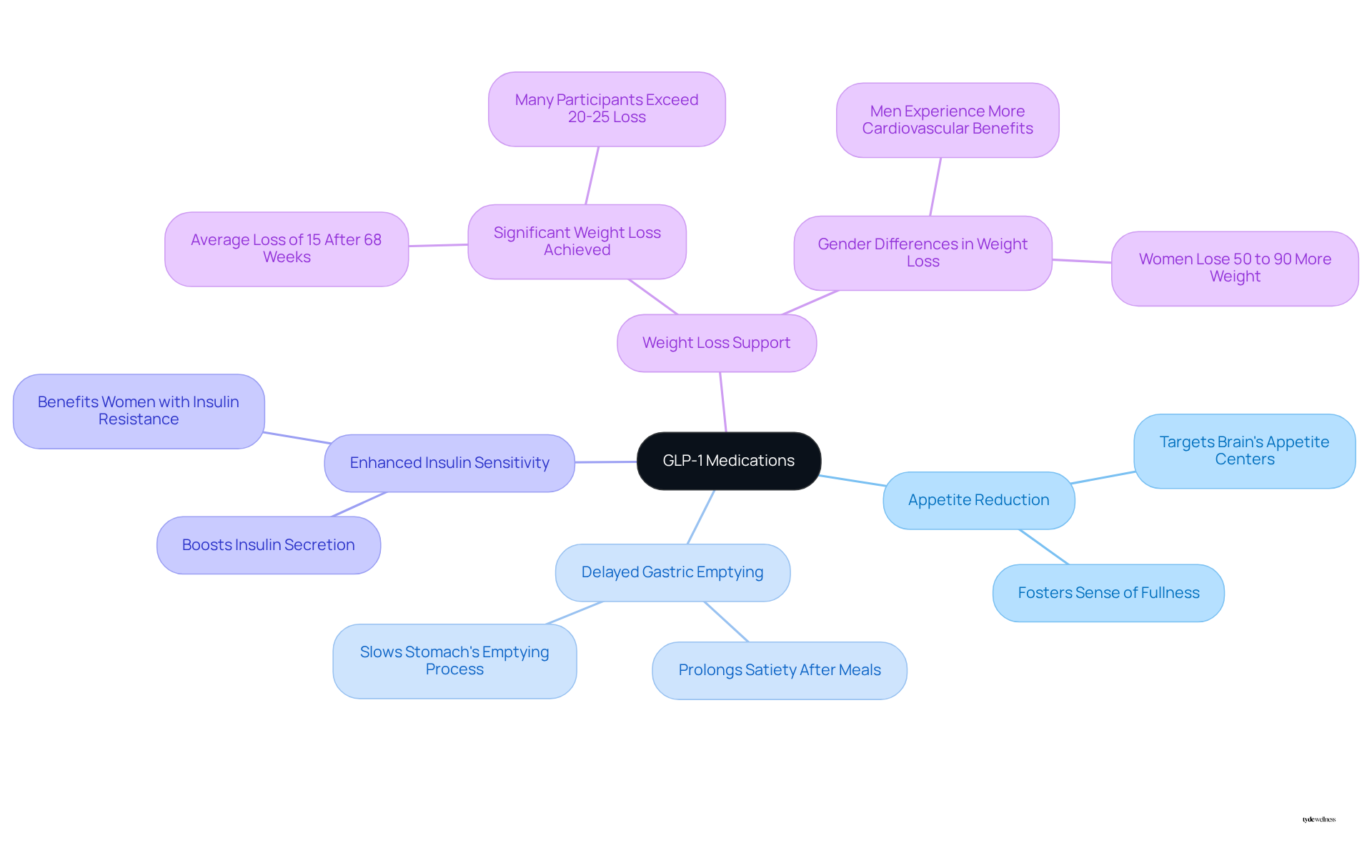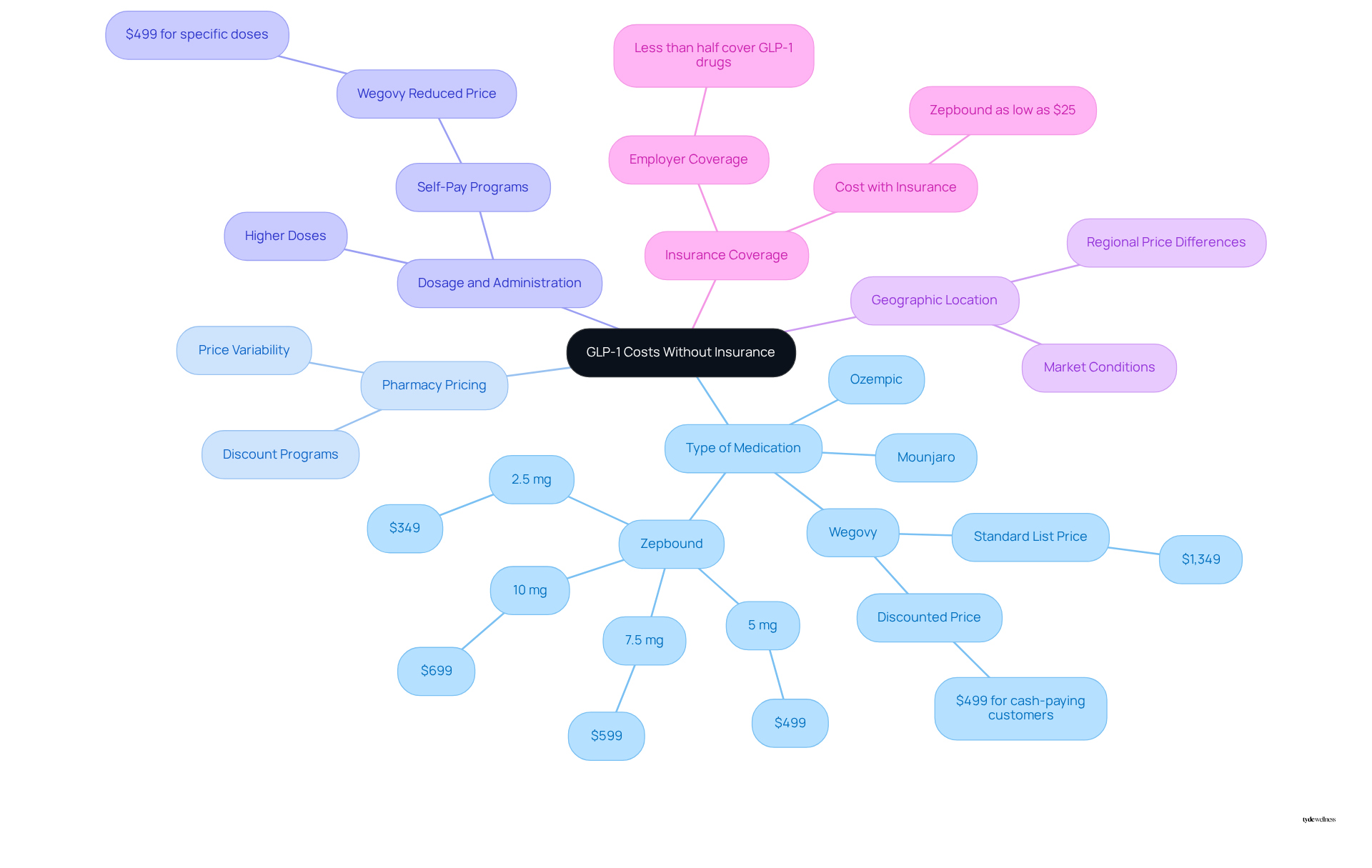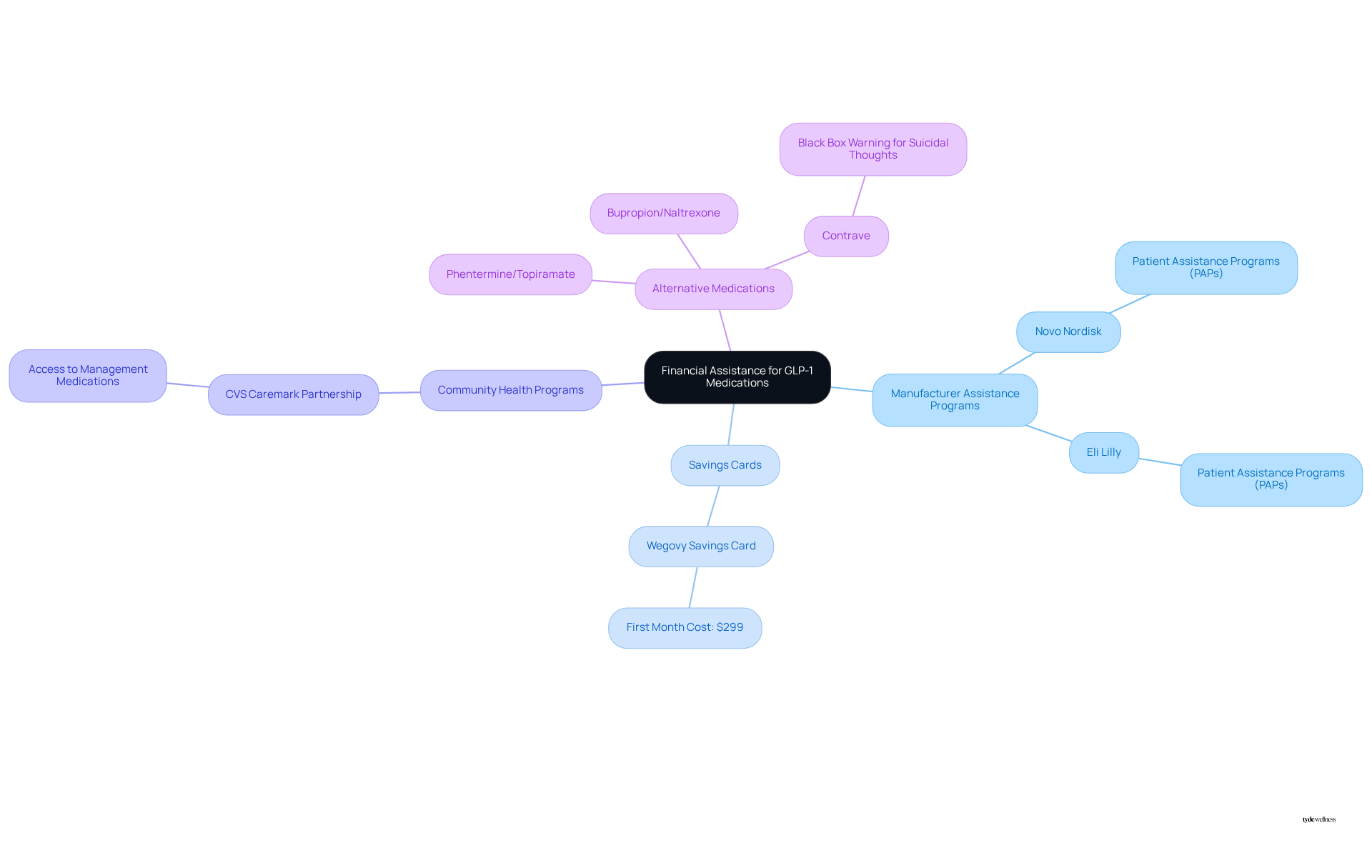Overview
The article examines the costs associated with GLP-1 medications for women lacking insurance, emphasizing the notable variations in pricing that arise from factors such as medication type, pharmacy pricing, and geographic location. While these medications can be quite costly, it highlights that financial assistance programs and alternative medications are accessible to help women manage these expenses. This support ultimately facilitates access to effective weight loss treatments, ensuring that women can pursue their health goals.
Introduction
Navigating the landscape of GLP-1 medications can be challenging, particularly for women seeking effective solutions for weight management and metabolic health. These innovative therapies offer notable benefits, including appetite suppression and improved insulin sensitivity. However, the financial burden, especially without insurance, can be significant.
How can women access these essential treatments while managing the often high costs associated with them? This article explores the complexities of GLP-1 pricing, the factors influencing costs, and the available financial assistance options, empowering women to make informed decisions on their health journeys.
Explore GLP-1 Medications: Mechanisms and Benefits
Glucagon-Like Peptide-1 therapies represent a category of substances that replicate the function of a hormone crucial for appetite regulation and glucose metabolism. These medications provide several key benefits:
- Appetite Reduction: By targeting the brain’s appetite centers, GLP-1 medications foster a sense of fullness, resulting in decreased food intake.
- Delayed Gastric Emptying: They slow the stomach’s emptying process, prolonging the feeling of satiety after meals.
- Enhanced Insulin Sensitivity: These treatments boost insulin secretion in response to meals, which is particularly advantageous for women facing insulin resistance during hormonal fluctuations.
- Significant Weight Loss Support: Clinical studies reveal that women utilizing certain treatments can achieve substantial reductions in body mass, often exceeding 15% of their total weight over time. Many participants in programs like Tyde Wellness report reductions surpassing 20-25% within a year.
These mechanisms position these medications as an effective option for women, especially those undergoing life transitions such as postpartum recovery or menopause, where hormonal variations can complicate body mass management. For instance, participants in programs like Tyde Wellness have reported an average weight loss of 15% after 68 weeks, with many attaining even greater results. This underscores the potential of this therapy to facilitate lasting health changes.

Assess GLP-1 Costs Without Insurance: Key Factors
The glp-1 cost without insurance can vary significantly due to several key factors.
-
Type of Medication: Different GLP-1 medications, such as Ozempic, Wegovy, and Mounjaro, typically range from $700 to $1,500 per month. For example, while Wegovy’s standard list price is $1,349, the glp-1 cost without insurance has been reduced to around $499 for cash-paying customers through specific pharmacies.
-
Pharmacy Pricing: Prices can differ widely between pharmacies. Some pharmacies provide discounts or savings programs that can greatly reduce out-of-pocket expenses. For instance, Zepbound’s pricing varies by dosage: 2.5 mg vials are $349, 5 mg vials are $499, 7.5 mg vials at $599, and 10 mg vials at $699.
-
Dosage and Administration: The price can rise with higher doses or more frequent administration. For example, while a month’s supply of Wegovy may cost around $1,349, certain self-pay programs can reduce this to approximately $499 for specific doses.
-
Geographic Location: Prices may also vary by region, influenced by local market conditions and pharmacy competition. This variability can influence the glp-1 cost without insurance that individuals have to pay for their medications.
-
Insurance Coverage: It’s important to note that less than half of large employers cover GLP-1 drugs for obesity. If approved by insurance, the monthly cost for Zepbound could drop to as little as $25, significantly impacting out-of-pocket expenses for patients.
By understanding these factors, including the average body weight loss of 15% reported after 68 weeks in the Tyde Wellness program, women can better navigate their options and make informed decisions about their weight loss journey. As Dr. Louis Aronne observed, the pricing environment for these treatments has become progressively competitive, which may offer more accessible choices for those in need.

Navigate Financial Assistance and Alternatives for GLP-1 Medications
For women grappling with the GLP-1 cost without insurance, several financial assistance options and alternatives can provide relief.
-
Manufacturer Assistance Programs: Pharmaceutical companies such as Novo Nordisk and Eli Lilly offer patient assistance programs (PAPs) that can significantly reduce or even eliminate the cost of GLP-1 medications for eligible patients. These programs are designed to improve access to essential treatments, particularly for those facing financial hardships. Notably, individuals in Tyde Wellness have reported an average body weight reduction of 15% after 68 weeks, underscoring the efficacy of these treatments.
-
Savings Cards: Numerous producers provide savings cards that lower the monthly expense of pharmaceuticals. For instance, Wegovy’s savings card allows eligible patients to pay as little as $299 for the first month, making it more accessible for those in need.
-
Community Health Programs: Local health organizations often offer resources or initiatives aimed at assisting low-income individuals with prescription costs. For example, CVS Caremark has partnered with Novo Nordisk to enhance access to management medications, which can be crucial for those who may not qualify for manufacturer support.
-
Alternative Medications: If GLP-1 medications remain financially unfeasible, discussing alternative weight loss medications with a healthcare provider is advisable. Options such as phentermine/topiramate or bupropion/naltrexone may present more affordable solutions while still proving effective. However, it is important to note that some alternatives, like Contrave, carry a black box warning for suicidal thoughts and behaviors, which should be carefully considered when exploring options.
By utilizing these resources, women can access the treatments they need without compromising their financial stability, ultimately supporting their health and wellness journey. As noted by expert Mansoor Amiji, ‘GLP-1s are revolutionary drugs in the treatment of obesity, but the GLP-1 cost without insurance is very expensive, creating a real barrier to people who need access to these drugs.

Conclusion
Understanding the costs associated with GLP-1 medications without insurance is crucial for women seeking effective weight management solutions. These therapies, which mimic a hormone vital for regulating appetite and glucose levels, offer significant benefits, particularly for women experiencing hormonal changes. However, the financial burden can be daunting. Therefore, it is essential to explore various options for accessing these medications affordably.
Several critical factors influence the cost of GLP-1 medications, including:
- The specific medication type
- Pharmacy pricing
- Dosage requirements
- Geographic location
- Insurance coverage
By being aware of these elements, women can make informed decisions regarding their treatment options. Furthermore, the availability of financial assistance programs, savings cards, and community health resources can alleviate the financial strain associated with these medications. This ensures that women can pursue effective weight loss strategies without compromising their financial health.
As the landscape of GLP-1 medications continues to evolve, it is vital for women to stay informed about their options and seek out available resources. By understanding the mechanisms of GLP-1 therapies and leveraging financial assistance programs, individuals can navigate the complexities of medication costs and take proactive steps toward achieving their health goals. Empowerment through knowledge and access can pave the way for lasting health improvements and enhanced quality of life.
Frequently Asked Questions
What are GLP-1 medications?
GLP-1 medications are therapies that replicate the function of the glucagon-like peptide-1 hormone, which is crucial for appetite regulation and glucose metabolism.
What are the main benefits of GLP-1 medications?
The main benefits include appetite reduction, delayed gastric emptying, enhanced insulin sensitivity, and significant weight loss support.
How do GLP-1 medications help with appetite regulation?
They target the brain’s appetite centers to foster a sense of fullness, which results in decreased food intake.
What effect do GLP-1 medications have on gastric emptying?
These medications slow the stomach’s emptying process, prolonging the feeling of satiety after meals.
How do GLP-1 medications enhance insulin sensitivity?
They boost insulin secretion in response to meals, which is particularly beneficial for women experiencing insulin resistance due to hormonal fluctuations.
What weight loss results have been observed with GLP-1 medications?
Clinical studies indicate that women using certain GLP-1 treatments can achieve significant weight loss, often exceeding 15% of their total weight, with some reporting reductions of 20-25% within a year.
Who can benefit from GLP-1 medications?
These medications are particularly effective for women undergoing life transitions such as postpartum recovery or menopause, where hormonal variations can complicate body mass management.
What weight loss results have participants in programs like Tyde Wellness reported?
Participants have reported an average weight loss of 15% after 68 weeks, with many achieving even greater results.
List of Sources
- Explore GLP-1 Medications: Mechanisms and Benefits
- Women in Menopause Benefit From GLP-1 Weight-Loss Medications as Much as Younger Women | Research | Advances in Endocrinology, and Women’s Health | NewYork-Presbyterian (https://nyp.org/advances/article/women-in-menopause-benefit-from-glp-1-weight-loss-medications-as-much-as-younger-women)
- Popular injected weight loss medications work better for one sex. Researchers want to know why | CNN (https://cnn.com/2025/05/16/health/glp-1-weight-loss-medications-women-men)
- Weight loss drugs could be a gamechanger for women with a common hormonal disorder (https://cnbc.com/2025/07/20/weight-loss-drugs-could-help-treat-pcos.html)
- Study identifies benefits, risks linked to popular weight-loss drugs | WashU Medicine (https://medicine.washu.edu/news/study-identifies-benefits-risks-linked-to-popular-weight-loss-drugs)
- GLP-1 Receptor Agonists May Modestly Reduce Risk of Fourteen Obesity-Related Cancers for People with Diabetes – ASCO (https://asco.org/about-asco/press-center/news-releases/glp-1-receptor-agonists-may-modestly-reduce-risk-obesity-related-cancers-people-with-diabetes)
- Assess GLP-1 Costs Without Insurance: Key Factors
- Ozempic: Hidden Costs Can Drain Your Wallet While on Weight Loss Drugs (https://healthline.com/health-news/why-taking-ozempic-wegovy-or-mounjaro-may-cost-more-than-you-think)
- Makers of Wegovy & Zepbound Cut Prices for Those Without Insurance (https://gastroenterologyadvisor.com/news/makers-of-wegovy-zepbound-cut-prices-for-those-without-insurance)
- Cost of Popular Weight Loss Drugs Goes Down for People Without Insurance (https://keckmedicine.org/blog/cost-of-popular-weight-loss-drugs-goes-down-for-people-without-insurance)
- The cost of weight loss drugs is finally dropping. How low can prices go? (https://nbcnews.com/health/health-news/cost-weight-loss-drugs-wegovy-zepbound-how-low-prices-down-rcna205911)
- Wegovy price cut: Novo Nordisk cuts the price of the weight-loss drug for the uninsured (https://usatoday.com/story/money/business/2025/03/05/weight-loss-drug-wegovy-price-cut/81613259007)
- Navigate Financial Assistance and Alternatives for GLP-1 Medications
- Novo Nordisk Patient Assistance Program (PAP) | NovoCare® (https://novocare.com/diabetes/help-with-costs/pap.html)
- Why are lower-cost weight-loss drugs not available? A Northeastern expert explains (https://news.northeastern.edu/2025/06/25/low-cost-weight-loss-drugs)
- Improving access and affordability to high-cost weight management drugs (https://cvshealth.com/news/pbm/improving-access-and-affordability-to-high-cost-weight-management-drugs.html)
- Major insurance changes are coming to GLP-1 drugs for weight loss. Here’s how that could affect patients | CNN (https://cnn.com/2025/07/01/health/zepbound-wegovy-insurance-cvs-bcbs-weight-loss)
- Express Scripts expands Patient Assurance Program to drive affordability and access to GLP-1s (https://evernorth.com/articles/express-scripts-expands-patient-assurance-program-drive-affordability-and-access-glp-1s)